Rajesh Kumar Thakur
It seems Plato was right when he said God geometrizes continually. Geometrical shapes can be seen aplenty in nature – tree stumps have concentric circles, a pebble thrown in water produces concentric circles, bee hives are hexagonal in shape. The construction of buildings, railway lines, monuments also need a mastery of geometry. In the Vedic era, rishis used to build altars for religious rites of sacrifice. The shapes of such altars were mostly a right angled triangle. A knotted rope of length 3, 4, 5 hasta (hand) was used to make such altars1. A falcon shaped altar also used to be constructed in five layers with 200 bricks for each layer making the total number of bricks used for constructing the altar, 1000 (200×5). The bricks used for the platform were of five different shapes. These bricks were made by a special class of people. No burnt bricks were used for the purpose. Only sun-dried bricks were used for constructing the altar. It was believed that offering a sacrifice on such an altar would enable a falcon to carry the soul of a supplicant directly to heaven2.

In the construction of the temple of Athena Parthenos the Pythagorean Theorem was used. The length, breadth and height of the temple are 69.5m, 30.88m and 13.72m respectively which are in the ratio of 16: 36:81.
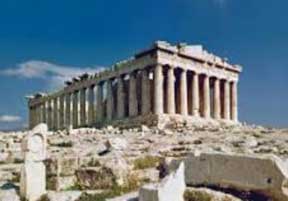
The use of the golden triangle is evident in the construction of the pyramids. Do you know why triangles are used to build bridges and buildings? Triangles are the only polygons that cannot be changed into a new shape without changing the length of one or more of their sides, also triangles are the only polygons with the least number of sides.

We can be sure that Egyptian architects had knowledge of advanced mathematics as can be seen in the pyramids they built and interestingly they used the value of π as 3. The maximum error in the length of the sides of the great pyramid is only 0.63 inches which is 1/14000 of the total length; moreover the error in the angle at the pyramidal corner is no more than 12’’ of a degree, i.e., 1/27000 of the angle 90°.
It is not just the ancient constructions that have mathematics built into them. Let us take a look at a few modern mathematically designed buildings.
1. Mobius Strip Pagoda
This Buddhist temple in Taichang, China, takes the shape of a Mobius ring, reflecting the basic principles of Buddhism and the idea of reincarnation.
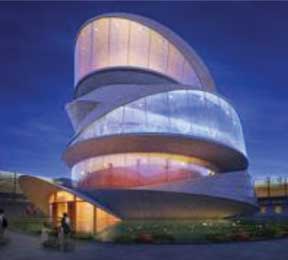
2. Tetrahedral-shaped Church
The tetrahedron is a convex polyhedron with four triangular faces. This church, in Colorado, USA, consists of a tubular steel frame of 100 identical tetrahedrons. Each tetrahedron is 75′-0″ long, weighs five tons, and is enclosed with clear aluminum panels. Each tetrahedron is spaced a foot apart, creating gaps in the framework,which have been filled with one-inch thick coloured glass. At the chapel level, the tetrahedrons between the spires have been filled with a mosaic of coloured glass in an aluminum frame. The structure rises 150′-0″ from hinge to pinnacle, has an overall length of 280′-0″, and is 84′-0″ wide from hinge to hinge.
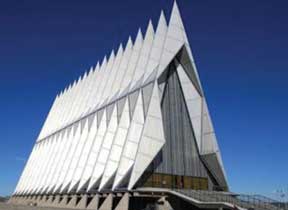
3. Experimental math-music pavilion
The Philips Pavilion in the shape of an asymmetric hyperbolic paraboloid was built in 1958 in Brussels. The pavilion was designed to house a multimedia spectacle that celebrated post-war technological progress.
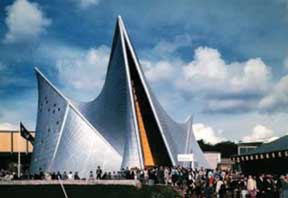
4. Cube Houses
The Cube Houses were built by Dutch architect Piet Blom in Rotterdam, Netherlands. Blom tilted the cube of a conventional house to 45°, and rested it upon a hexagon-shaped pylon. His design represents a village within a city, where each house represents a tree, and all the houses together, a forest.
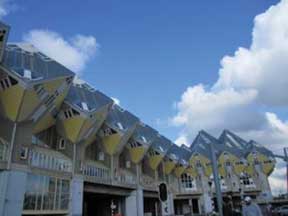
5. Magic Square Cathedral
The Sagrada Familia cathedral in Barcelona designed by Antoni Gaudí is a mathematician’s dream. The cathedral also contains a magic square – an arrangement of numbers that add up to the same in every column, row and diagonally as well. The magic number in Sagrada Familia is 33, which alludes to multiple religious symbols, such as Jesus performing 33 recorded miracles, the belief that he was crucified at the age of 33 in 33 A.D.
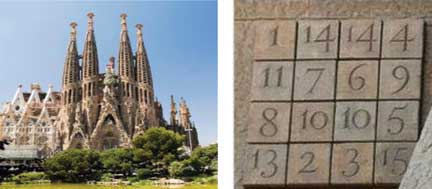
The Nasir al Mulk mosque in Iran is pentagonal in shape. Its ceiling is designed with different geometrical shapes like semicircle, square, pentagon, hexagon and octagon.

The Brihadeshvara temple at Thanjavur, now a part of UNESCO World Heritage Sites, is one of the best examples of axial and symmetrical geometry rules. The entrance of Parshavanath Jain temple in Khajurao Madhya Pradesh shows the first 4 x 4 magic square whose sum total is 34. The assembly building of Chandigarh planned by Swiss-French architect Le Corbusier is based on the Golden ratio.
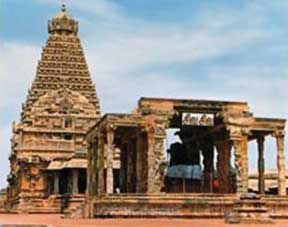
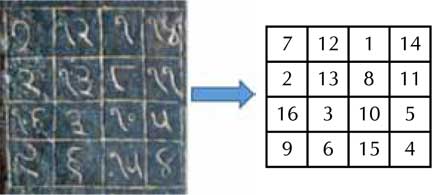
There are several other monuments, buildings in the world which have been or are being designed using the principles of mathematics. These structures are all examples of how in real life the principles of mathematics are applied to the designing of buildings. The use of mathematics is not limited to calculations but also shows how math can be used to create beauty.
References
1 & 2: Taken from the Shulba Sutra of Baudhayan. The Shulba Sutras are part of larger texts, which are considered to be appendices to the Vedas. The Shulba Sutras are the only sources of knowledge of Indian mathematics during the Vedic period. The Sutra text contain geometry related to fire altar construction.
The author is a mathematics teacher in a Delhi Government School, Sector -16 Rohini. He has written books, ebooks, articles and blogs on mathematics. He is an expert committee member of Vidyarthi Vigyan Manthan, NCERT, CBSE and AIRMC. He can be reached at rkthakur1974@gmail.com. He tweets at @R_K_THAKUR.
